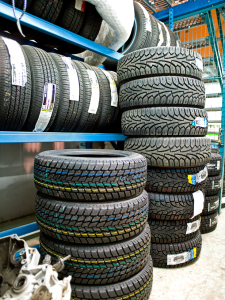Weight and your Tires 
Just what tires do you need to carry the family or whatever you are transporting? Our 25 years of tire and wheel service can service you today
Recommended tire weight considerations are based on a number of factors and the speed you travel in your vehicle. Below are listed basic factors, the chart further down the page lists in more detail more factors.
- Recommended tire inflation pressure
- Vehicle type capacities (VCW–the maximum occupant/cargo weight a vehicle is designed to carry)
- Front and rear gross axle weight ratings (GAWR– the maximum weight the axle systems are designed to carry).
Placards and certification labels are permanently attached to the vehicle door inside the door post area or glove-box door and can also be located inside your trunk lid.
You can also find the recommended tire pressure and load limit for your vehicle in the vehicle owner’s manual or at the vehicle manufactures website.
| Many factors directly how your car operates when you drive it, but few factors have such direct effect on how your car actually handles the road as your tires. It is definitely in your best interest to have a good knowledge of your tires capabilities and more importantly, their limitations. Exceeding the "Speed Rating" or loading to much weight your vehicle can have a negative impact on your tires. That’s where tire service descriptions come in. Service descriptions let you know your tires’ load limit and speed rating. | ||||||||||||||||||||||||||||||||||||||||||||||||||||||||||||||||||||||||||||||||||||
| SO, JUST HOW MENY PEOPLE AND SUIT CASES CAN I PUT INTO MY CAR??......... | ||||||||||||||||||||||||||||||||||||||||||||||||||||||||||||||||||||||||||||||||||||
| So just how much weight is too much weight and how fast is too fast? It varies depending on the tires. Your tires’ weight and speed limits are indicated by the tire service description; a short code located on the sidewalls of your tires that. This short code, which consists of a two or three digit number along with a single letter, designates just how much weight your tires are capable of carrying safely and the maximum speed the tires are designed for. | ||||||||||||||||||||||||||||||||||||||||||||||||||||||||||||||||||||||||||||||||||||
| ||||||||||||||||||||||||||||||||||||||||||||||||||||||||||||||||||||||||||||||||||||
| The numbers in a tire service description designates the tire’s load index. The number doesn’t indicate the actual weight the tire is capable of supporting. Rather, it's a code that corresponds with an actual weight. You can decode this number with a load index chart. The higher a specific tire’s load rating is, the greater its capacity for carrying loads. Typical load indexes on passenger cars and light trucks range from 70-110, which as you can see below indicate weight from 739-2337 pounds. |

